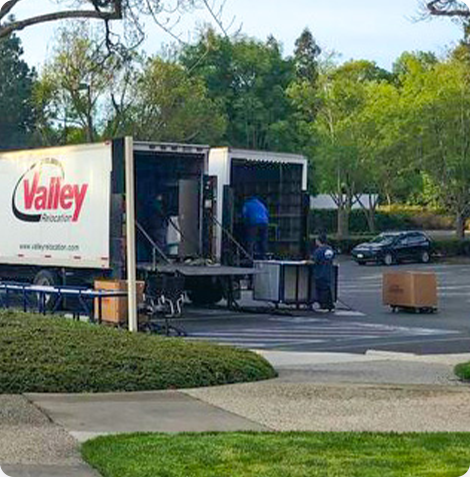In the fast-paced world of commerce, change is the only constant. Businesses evolve, expand, and adapt to meet the dynamic demands of their industries. A crucial aspect of this evolution often involves changing physical locations, be it to accommodate growth, seek more favorable markets, or optimize operations. Commercial relocation, while full of opportunities, is a complex and challenging endeavor. It’s a transformation that necessitates meticulous planning, precise execution, and the ability to foresee and mitigate potential pitfalls.
Amidst the myriad tasks and decisions involved in commercial relocation, one aspect often overlooked but undeniably pivotal is the site survey. It’s the hidden hero in the process, quietly ensuring that your move unfolds seamlessly. In this blog, we delve into the heart of this matter, shedding light on why free site surveys are indispensable in the art of commercial relocation.
Picture this: Your business is on the verge of a significant transition, and the allure of a new location promises growth and improved prospects. It’s an exciting moment filled with anticipation. Yet, beneath the surface of this excitement lies an intricate web of challenges that could unravel your dreams if not approached with due diligence. This is where the importance of free site surveys becomes strikingly evident.
In the chapters that follow, we will journey through the commercial relocation landscape, exploring the intricacies of site surveys and how they serve as the compass guiding your business through these transformative waters. We’ll uncover the benefits, the key elements, and the precise process that make free site surveys an invaluable asset.
Moreover, we will share real-life success stories that showcase how businesses have leveraged this often underestimated tool to not only survive but thrive during their relocations. We’ll also tackle the common challenges that can arise, offering solutions to help you navigate the change with confidence.
As we navigate this crucial aspect of commercial relocation, remember that while the process may be intricate, it doesn’t have to be daunting. With the right knowledge and understanding, you can transform your business into an opportunity for growth, efficiency, and success. So, let’s embark on this journey together and uncover the importance of free site surveys in commercial relocation – the silent architects of your business’s future.
The Commercial Relocation Landscape: Navigating Change with Precision
In the ever-evolving world of business, change is not merely a buzzword; it’s an essential survival strategy. One of the most significant shifts a company can make is relocating its commercial operations. This decision is driven by several compelling reasons, each with its unique set of challenges and complexities. In this blog, we will delve into the dynamic landscape of commercial relocation, shedding light on the motivations, obstacles, and the paramount role of planning and preparation.
Reasons for Commercial Relocation
Businesses opt for commercial relocation for a variety of compelling reasons, each tied to its growth and sustainability. Some of the primary motivations include:
- Expansion:As a business grows, it often outgrows its current space. Relocating to a larger facility becomes necessary to accommodate increased staff, equipment, and inventory.
- Market Access: Proximity to markets and customers can significantly impact a business’s success. Companies often relocate to strategically position themselves in more favorable locations.
- Cost Savings: In some cases, relocating to an area with lower operational costs, such as lower taxes or utility expenses, can boost profitability.
- Optimizing Operations: Businesses might relocate to streamline their supply chain, improve logistics, or enhance overall efficiency.
- Upgrading Facilities: An aging or outdated workspace can hinder productivity and employee morale. Relocation can provide an opportunity to upgrade to modern, more functional facilities.
Challenges and Complexities
While the promise of growth and improvement often motivates commercial relocation, it comes with its fair share of challenges and complexities:
- Downtime: One of the most significant challenges is minimizing downtime during the move. Any interruption in operations can result in financial losses and customer dissatisfaction.
- Logistics:Coordinating the transportation of equipment, inventory, and personnel can be a logistical nightmare. Ensuring that everything arrives at the new location intact and on time is a complex task.
- Legal and Regulatory Compliance: Complying with local zoning laws, permits, and other regulations can be a time-consuming process that demands careful attention to detail.
- Employee Concerns:The relocation might necessitate that employees move as well, which can lead to concerns about job security, lifestyle changes, and the overall impact on their lives.
- Cost Overruns: Managing costs is a significant challenge. Unexpected expenses can quickly add up if not accounted for in the planning stage.
Planning and Preparation
In the face of these challenges, meticulous planning and preparation become paramount:
- Create a Detailed Plan: Start early and develop a comprehensive relocation plan that outlines timelines, responsibilities, and contingencies for unexpected events.
- Engage Professionals: Consider enlisting the help of professional commercial relocation experts who have experience in managing complex moves.
- Communication: Maintain transparent communication with employees throughout the process. Address their concerns and provide support when needed.
- Budget Wisely: Allocate a budget that accounts for both expected and unexpected expenses. Leave room for contingencies.
- Legal Compliance: Ensure you understand and comply with all legal and regulatory requirements in both the old and new locations.
What Is a Site Survey in the Context of Commercial Relocation?
A site survey, in the context of commercial relocation, is a comprehensive and systematic assessment of both the current and prospective locations where a business plans to move its operations. It serves as a critical initial step in the planning and preparation phase of commercial relocation. Site surveys are typically conducted by professional surveyors or relocation experts who specialize in assessing the physical, logistical, and infrastructural aspects of a business’s potential new site.
Defining a Site Survey in Commercial Relocation
A site survey can be defined as a meticulous examination and evaluation of various factors that can significantly impact a business’s decision to relocate or expand to a new commercial space. This evaluation includes a thorough inspection of the current workspace and a detailed examination of the prospective site. The aim is to provide a comprehensive understanding of the conditions, opportunities, and challenges associated with the new location.
The Purpose of a Site Survey
A site survey serves several essential purposes in the context of commercial relocation:
Data Collection: Site surveys involve collecting a wide range of data, such as the dimensions and layout of the current and potential spaces, infrastructure details (e.g., electrical, plumbing, HVAC systems), and any potential limitations or issues that may arise during the move.
Risk Assessment: By examining the physical condition of the new site and identifying any potential obstacles or hazards, site surveys help businesses assess the level of risk associated with the relocation. This includes identifying structural issues, accessibility challenges, or compliance concerns.
Cost Estimation: Site surveys provide valuable information for estimating the costs associated with the relocation accurately. This includes not only the direct costs of moving but also any necessary modifications or improvements to the new space.
Decision-Making: Armed with the insights gained from a site survey, businesses can make well-informed decisions about whether the new location is suitable for their needs. It helps in determining whether the benefits of relocating outweigh the costs and potential challenges.
The Benefits of Free Site Surveys
When it comes to commercial relocation, businesses are faced with numerous decisions and challenges. Among these, the decision to opt for a free site survey stands out as a strategic choice that can significantly impact the success of the move. In this section, we’ll explore the advantages of choosing free site surveys, highlighting how they lead to cost savings, enhanced decision-making, and improved planning and logistics.
Cost Savings for Businesses
One of the most compelling benefits of free site surveys is the immediate cost savings they offer. By engaging in a site survey early in the relocation planning process, businesses can identify potential issues, such as structural deficiencies or the need for modifications, well before the move begins. This early awareness allows for more accurate budgeting, preventing unexpected costs from derailing the relocation project.
For example, imagine a company considering a move to a new office space. Without a site survey, they might budget for the move based on assumptions about the new location’s condition. However, during the survey, it’s discovered that the electrical wiring needs significant upgrades to accommodate the company’s needs. By uncovering this early, the business can budget for the necessary electrical work and avoid costly surprises during the move.
Enhanced Decision-Making
Free site surveys provide a wealth of information that empowers businesses to make informed decisions. From evaluating the suitability of the new location to assessing its compliance with safety regulations and accessibility requirements, the insights gained from a site survey help businesses weigh the pros and cons of the move with precision.
Consider a retail business looking to open a new storefront in a different neighborhood. A site survey may reveal that the chosen location has limited parking options and accessibility challenges for customers with disabilities. With this knowledge, the business can decide whether these issues are manageable or if an alternative location would be more suitable, all before signing a lease.
Improved Planning and Logistics
Site surveys serve as a foundational element in the planning and logistics of a successful relocation. They provide a detailed understanding of the layout, infrastructure, and potential obstacles in the new space. This information is invaluable for designing a relocation timeline, coordinating the move of equipment and inventory, and ensuring minimal disruption to daily operations.
Let’s take the example of a manufacturing company moving its operations to a larger facility. A site survey might reveal that certain heavy machinery requires special rigging equipment for safe transport. With this knowledge, the business can plan for the necessary equipment and personnel, ensuring a smooth and secure move.
Addressing Common Misconceptions about Site Surveys
Despite their numerous advantages, some common misconceptions about site surveys exist. One misconception is that site surveys are costly. However, as discussed earlier, free site surveys are available and can be instrumental in cost savings. Another misconception is that site surveys are time-consuming and delay the relocation process. In reality, the time invested in a site survey can prevent delays and challenges down the road, making the overall relocation process more efficient.
Steps Involved in Conducting a Site Survey
Initial Consultation and Planning
The site survey process typically begins with an initial consultation between the business and a professional surveyor or relocation expert. During this phase, the objectives, scope, and specific requirements of the survey are discussed and defined. The surveyor collaborates with the business to understand its goals, expectations, and any particular concerns.
On-Site Inspection and Data Collection
The heart of the site survey process involves visiting the current and prospective locations to conduct a detailed on-site inspection. Surveyors meticulously examine the physical attributes of both spaces, taking measurements, photographs, and notes. This stage includes a comprehensive evaluation of the buildings, infrastructure, utilities, and any potential obstacles or challenges. Data on electrical systems, plumbing, HVAC, accessibility, safety compliance, and more is collected to create a holistic view of the locations.
Analysis and Reporting
After the on-site inspection, the gathered data is thoroughly analyzed. This analysis encompasses a comparison of the business’s specific needs and requirements against the capabilities and limitations of the current and prospective spaces. Surveyors assess the viability of the relocation and identify any potential issues or opportunities. The results of this analysis are then compiled into a detailed report, which serves as a critical reference for the subsequent stages of the relocation process.
Recommendations and Action Plan
Based on the findings of the analysis, professional site surveyors formulate recommendations and develop a comprehensive action plan. This plan outlines the steps and strategies required to address any challenges, optimize the new space, and ensure a seamless transition. It includes prioritized recommendations for renovations, modifications, infrastructure upgrades, and compliance measures. This actionable plan serves as the roadmap for businesses to follow as they progress toward their relocation goals.
Timeline of a Typical Site Survey
The timeline of a site survey can vary depending on the complexity of the relocation and the specific requirements of the business. However, in a typical scenario, the site survey process can span several weeks. The initial consultation and planning phase may take a few days to a week. The on-site inspection and data collection stage generally requires several days to thoroughly evaluate both locations. The analysis and reporting phase could take an additional week or two, while the recommendations and action plan development may add another week to the timeline.
Valley Relocation Carrying Out Comprehensive Moving Services
Carrying out commercial relocations can be exhausting, especially when movers and business owners aren’t prepared for what’s coming their way. Luckily, with Valley Relocation, you don’t have to worry about anything else. They carry out a detailed free site survey for their clients to ensure they have everything that the commercial relocation might need.
Once they have the details they need, they use a range of moving services, including warehouse storage services, commercial relocation, facility services, and so much more. Contact us now for more information.





